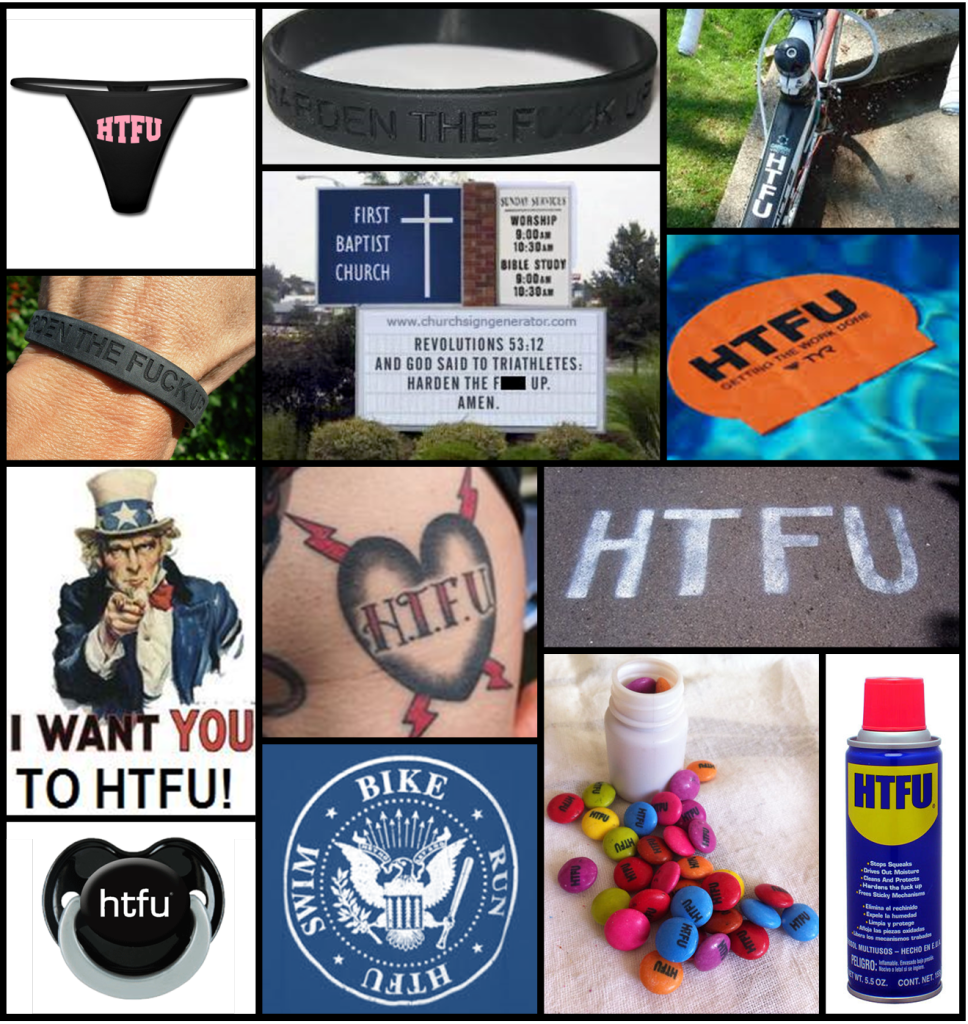The endurance sports community holds HTFU as a sacred doctrine. In some circles, it’s the default response to any complaint, excuse or sign of weakness. Tales of HTFU are spun and swapped among athletes, their merit measured in broken bones, road rash, frostbitten digits, blood, sweat and other bodily fluids (except tears—they’re not allowed).
Naturally, entrepreneurs have capitalized on our HTFU obsession. Triathlete’s hunger for carbs is second only to their insatiable appetite for tri-themed paraphernalia. You can buy HTFU clothing, caps, wristbands, stickers, bottles, underwear, mugs, stamps, gift packs and pills (guaranteed to “improve your Strava times”). You can even get ’em started young with an HTFU pacifier. And for the triathlete who has it all, an HTFU tattoo is sure to be a tasteful and timeless way to proclaim your personal philosophy.
But hold on… put your credit card down…
There’s a time and place to HTFU. But is it always the right approach? As I discovered, when it comes to winter training, it pays to be choosy with when and how you HTFU.
Mental endurance, or the capacity to HTFU, is a limited resource. Like physical endurance, it can be improved with time and experience, but it is nonetheless finite. Just as there is only so much training load an athlete can absorb before their body breaks down, there is also a limit to the amount of discomfort, suffering, sacrifice, and monotony an athlete can (or is willing) to endure before burnout sets in. In fact, coping with mental and physical stress draws on some of the same reserves [e.g., 1, 2, 3, 4, 5].
Think of HTFU as gas in the tank. For a competitive athlete, the goal is to hit race season with a full tank, firing on all cylinders—highly motivated and eager to suffer. A hard block of training or even a single tough workout burn some mental fuel, but a little R&R is enough to top up the tank. Off-season training is not the time to drain the tank. You don’t want to find yourself running on empty come race season—undermotivated and unwilling to suffer. And if you really blow off regularly scheduled maintenance, you could find yourself in need of a complete engine overhaul—serious unplanned downtime.
Training through a Canadian winter provides daily opportunities to HTFU. Last year, when snow storms rolled in hours before every single run workout for a month, I couldn’t shake the feeling that Old Man Winter was personally testing me. “What will it take to make Cody crack?” he would say to himself, cackling and rubbing his ice-blue hands together with glee as he pitched another squall my way.

This winter, faced with the double whammy of the Great Ice Storm of 2013 and the Polar Vortex, I came up with a new approach to off-season training:
Cold, dark, long, hard, solo – pick 3 per session, max. My off-season training philosophy to keep the fire burning.
— Cody Beals (@CFBeals) December 12, 2013
I did my best to heed my own advice, but my stubborn insistence on doing 100% of my running outdoors—up to 100 km a week—proved to be very trying. This January brought me to me knees… literally. It started with a bitterly cold and windy tempo run and an unfortunate undergarment choice.
Men of the North, I’m looking for windproof/thermal underwear rec’s. Crying in fetal pos. after 22k run in -17°C. #ManProblems #reproduction
— Cody Beals (@CFBeals) January 9, 2014
I’m not sure if it was a pain-induced delusion or if I was actually hearing the terrified screams of my unborn children. The would-be grandparents also took an uncomfortable interest in my predicament. But no worries; five agonizing minutes later, I was fine.
A few days later, I skated my way through a treacherous long run only to fall hard on my own driveway when I let my guard down.
I finished my next workout with bloody feet and holes in my favourite socks after the screws in my shoes pushed through the thin soles. I didn’t notice the pain until my numb feet thawed out.

After that, I spent a few weeks floundering in the snow, waddling around in triple layers, and grinding my teeth in frustration to keep them from chattering.
28k in -28°C windchill. Building an epic pillow fort, filling it with snacks & not coming out until spring. #SoThere
— Cody Beals (@CFBeals) January 26, 2014
Ok, that was a little melodramatic, but this was the final straw:
Frostbit the tip of my nose running in -33C windchill yesterday. Cue the #Rudolph jokes…
— Cody Beals (@CFBeals) January 29, 2014
During that run, I passed the window of a fitness club where a row of treadmillers plodded merrily away, oblivious to the harsh elements. Bent over double into the driving snow, I suddenly forgot my longstanding disdain for treadmills. I realized that treadmills weren’t the soft option, they were the smart option.
This winter has broken me. I have a long, painful app’t with the #dreadmill tomorrow, my 2nd ever.
— Cody Beals (@CFBeals) January 31, 2014
Three steps into my first treadmill workout, I found myself grinning. No squinting through ice-encrusted eyelashes, clenching numb fingers, flailing for traction, sucking stale air through a crusty scarf, no freezing… um… extremities… And I even had an attractive audience for extra motivation!
Eliminating all the peripheral annoyances and discomforts that had sapped my mental energy allowed to focus completely on the actual workout.
Consider this my public apology for hating on treadmills. Did 20+km of penance & loved every cozy, ice-free step. #convert
— Cody Beals (@CFBeals) January 31, 2014
If I still wasn’t completely sold on treadmills, an endorsement from fellow Ontario pro and MultiSport Canada Recharge With Milk Ambassador Lionel Sanders convinced me. He knows a thing or two about running and happens to be quite the ‘mill maven.
@CFBeals @andyboltz1 One good lateral injury from the ice, will convert you for life. Been on the treadmill exclusively for two months now.
— Lionel Sanders (@LSandersTri) January 31, 2014
So until the roads clear and the mercury rises, I’ll be hitting the ‘mill for my hard workouts. Trust me, there will be no shortage of HTFU, just a different, more productive kind.
My advice is that next time you HTFU, ask yourself if you’re using this limited resource in the wisest possible way, especially in midwinter.
How do you HTFU? Join the conversation on Facebook or Twitter.








